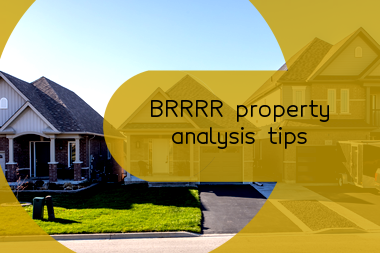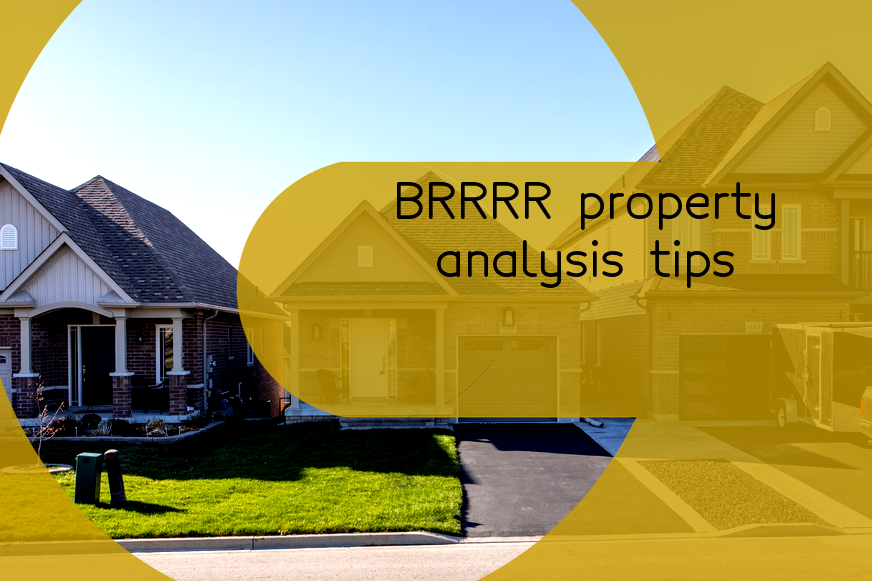BRRRR strategy stands for Buy, Rehab, Rent, Refinance, Repeat. This strategy is used in real estate investing to acquire a property, renovate or rehab it, rent it out, then refinance the property to take out cash for a down payment on another investment property.
Here is a step by step guide on how to analyze a BRRRR property:
- 1. Determine the arv (after repair value): This is the estimated value of the property after it has been fully repaired or rehabbed. You can determine the ARV by researching recent sales of similar properties in the area or by getting an appraisal.
- 2. Calculate the rehab cost: Estimate the cost of the necessary repairs or renovations required to bring the property up to market standards. Dont forget to account for any unexpected costs, contingencies or overruns.
- 3. Determine the purchase price: Research the current market value of the property and make an offer that is below or at market value. The goal is to find a good deal, so you make a profit during the later stages of the BRRRR strategy.
- 4. Estimate the rental income: Research rental rates in the area for similar properties and compare them to the monthly mortgage payment including taxes and insurance. This will give you an idea of the potential cash flow for the property.
- 5. Calculate the cash flow: Subtract the monthly mortgage payment, including taxes and insurance, from the projected monthly rental income. This will give you an idea of the potential cash flow for the property.
- 6. Calculate the cash-on-cash return: Divide the projected cash flow by the total cash invested, including the down payment, closing costs, and rehab costs.
- 7. Determine the refinancing options: Determine the loan-to-value (LTV) ratio that lenders in your area will allow for investment properties. This will help you calculate how much you can refinance the property for, allowing you to take out cash to pay for the down payment of another investment property.
- 8. Determine the ROI (Return on Investment): Calculate your expected return on investment, which includes the monthly cash flow and the appreciation of the property from the time you purchase it to when you sell it.
By following these steps, you can properly analyze a BRRRR property and determine if its a good investment opportunity or not.
What does BRRRR mean?
BRRRR stands for Buy, Rehab, Rent, Refinance, Repeat. It is a real estate investing strategy where an investor buys a property, improves it through rehabbing, rents it out to tenants, and refinances the property to extract the equity gained from the value appreciation and rental income. The investor repeats this process to acquire more properties and build a portfolio of cash-flowing assets. This strategy is often used by experienced investors who want to grow their wealth and generate passive income over time.
Pros of the BRRRR strategy
The BRRRR (Buy, Rehab, Rent, Refinance, Repeat) strategy is a popular real estate investment strategy that provides multiple benefits to investors. Some of the pros of the BRRRR strategy are:
- 1Increased Cash Flow: The BRRRR strategy can increase cash flow by purchasing distressed properties and refinancing them after rehabbing. The rental income generated from the property can be used to pay the mortgage, taxes, and other expenses, providing ongoing cash flow.
- 2Equity Buildup: Rehabbing a property can increase the value of the property, creating equity. Refinancing can then allow an investor to access that equity and use it to purchase additional investment properties or reinvest in the same property.
- 3Lower Risk: By purchasing distressed properties, an investor can acquire assets below market value, thereby lowering the risk. Additionally, rehabbing the property can increase its value, and renting it out can provide ongoing income, reducing the overall risk of the investment.
- 4Tax Benefits: Rental properties provide significant tax benefits such as depreciation, mortgage interest deductions, and property tax deductions.
- 5Increased Portfolio Size: By using the BRRRR strategy, an investor can recycle their invested capital, allowing them to build a larger portfolio of investment properties over time.
Overall, the BRRRR strategy is a great way for investors to acquire and build a portfolio of real estate assets that generate ongoing cash flow, increase equity, and provide significant tax benefits.
Cons of the BRRRR strategy
I can present the general cons of the BRRRR strategy:
- 1High upfront costs: The BRRRR strategy requires a significant amount of capital to purchase the property and carry out renovations. This can be a hurdle for many real estate investors with limited funds.
- 2Market risk: BRRRR strategy relies on the appreciation of property in a market. If the market undergoes a downturn, investors are likely to face difficulties in refinancing and reselling the property.
- 3Management complexities: The BRRRR strategy requires intensive management of multiple properties, contractors, and lenders. This can be overwhelming for inexperienced investors and can negatively affect their chances of success.
- 4Time-consuming: The BRRRR strategy is a long-term investment plan, involving a lot of time and effort to identify, purchase, renovate, rent and refinance a property. It is not suitable for investors who desire immediate returns.
- 5Uncertainty: Regardless of the thorough research or due diligence, there is always a degree of uncertainty associated with property acquisitions. Unexpected expenses or issues may arise during renovation or tenants may not pay on time or vacate early, causing financial strain to the investor.
- 6Dependence on third-party professionals: The BRRRR strategy requires investors to work with various professionals, including contractors, real estate agents, and lenders. The investor's success is dependent on their trustworthiness and performance, which can be difficult to control.
It is important to note that the BRRRR strategy, like any investment strategy, comes with risks. Investors must carefully weigh the risks and rewards before making any decision.
Analyzing a real-life BRRRR deal
I can give you a general idea about how analyzing a BRRRR deal works.
The BRRRR strategy stands for Buy, Rehab, Rent, Refinance, and Repeat. It is a popular real estate investing technique that involves buying distressed or undervalued properties, renovating them, renting them out, refinancing them at a higher value than their original purchase price, and reinvesting the profits into new properties.
To analyze a BRRRR deal, you need to consider several factors such as the purchase price, rehab costs, rental income, property taxes, insurance, maintenance costs, and refinance rates. These factors will help you determine whether the BRRRR deal is profitable or not.
First, you need to research the local real estate market and identify potential properties that are undervalued or distressed. Once you find a property that meets your criteria, you need to conduct a thorough inspection to determine the cost of renovations and repairs.
Next, you need to calculate the rental income that the property can generate after renovation and compare it with the expenses such as property taxes, insurance, and maintenance costs. You should also research the average rental rates in the area to make sure your property will be competitive.
After renting out the property for a few months, you can apply for a refinance loan based on the new, higher appraised value of the property. This will allow you to pull out cash and reinvest it in new properties.
Overall, analyzing a BRRRR deal requires careful research, due diligence, and an understanding of real estate financing and investing. If done correctly, the BRRRR strategy can be a lucrative and low-risk way to build wealth through real estate.
Who should use the BRRRR investment strategy?
The BRRRR investment strategy is a popular method that can be used by experienced real estate investors or those who are willing to put in the time and effort to learn and follow the steps involved. This strategy involves buying a distressed or undervalued property, rehabilitating it, renting it out, refinancing it to recoup the investment cost, and repeating the process with the newly acquired funds. It requires a significant amount of planning, research, and financial management skills. Therefore, it is not recommended for novice or inexperienced investors.
Just one more thing: if you liked the article, please like us on social media and share this article with friends.



